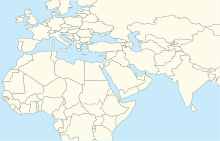This article includes a list of general references, but it lacks sufficient corresponding inline citations. (January 2019) |
King Khalid International Airport مطار الملك خالد الدولي Matār al-Malik Khālid al-Duwaliyy | |||||||||||||||
|---|---|---|---|---|---|---|---|---|---|---|---|---|---|---|---|
 | |||||||||||||||
 Satellite image of the airport | |||||||||||||||
| Summary | |||||||||||||||
| Airport type | Public | ||||||||||||||
| Owner/Operator | Riyadh Airports Company | ||||||||||||||
| Serves | Riyadh | ||||||||||||||
| Location | Riyadh, Saudi Arabia | ||||||||||||||
| Opened | 16 November 1983 | ||||||||||||||
| Hub for |
| ||||||||||||||
| Elevation AMSL | 2,049 ft / 625 m | ||||||||||||||
| Coordinates | 24°57′28″N 046°41′56″E / 24.95778°N 46.69889°E | ||||||||||||||
| Website | kkia | ||||||||||||||
| Maps | |||||||||||||||
 | |||||||||||||||
| Runways | |||||||||||||||
| |||||||||||||||
| Statistics (2018) | |||||||||||||||
| |||||||||||||||
King Khalid International Airport (Arabic: مطار الملك خالد الدولي Maṭār al-Malik Khālid al-Duwaliyy, IATA: RUH, ICAO: OERK) is an international airport located about 35 kilometres (22 mi) north of Riyadh, Saudi Arabia,[3] designed by the architectural firm HOK.[4] Arabian Bechtel Company Limited served as the construction manager on behalf of the Saudi government.
This airport consists of five passenger terminals (only three of which are in use), with eight aero-bridges each, a mosque, covered and uncovered car parking for 11,600 vehicles, an additional Royal Terminal (for the kingdom's guests, government heads, and Saudi royal family use), a central control tower (one of the world's tallest), and two parallel runways, each 4,260 metres (13,980 ft) long. Formerly the largest airport in the world in terms of ground area, the land area allocated for KKIA is the second-largest in the world, after King Fahd International Airport[5] as well as one of the busiest airports in the Middle East. The airport is managed and operated by Riyadh Airports Company. The Royal Mosque was designed with a significant programme of integral art; the stained glass, by British architectural artist Brian Clarke, was a landmark work in the history of the medium, considered to be the largest and technically most advanced stained glass project of the modern period.[6]
- ^ a b "26 million passengers visit Riyadh airport in 2018". 27 January 2019. Retrieved 23 September 2019.
- ^ 1 "AIP"
- ^ "King Khaled International Airport Overview". Flight Stats. Archived from the original on 25 December 2018. Retrieved 9 August 2012.
- ^ Kultermann, Udo (1999). Contemporary Architecture in the Arab States: Renaissance of a Region. McGraw Hill. pp. 144–145. ISBN 9780070368316.
- ^ "King Khaled International Airport, Riyadh, Saudi Arabia". Airport Technology. Verdict Media Limited. Retrieved 11 June 2020.
- ^ Amaya, Mario (June 1984). "Clarke's New Constructivism". Studio International. 197 (1005).





